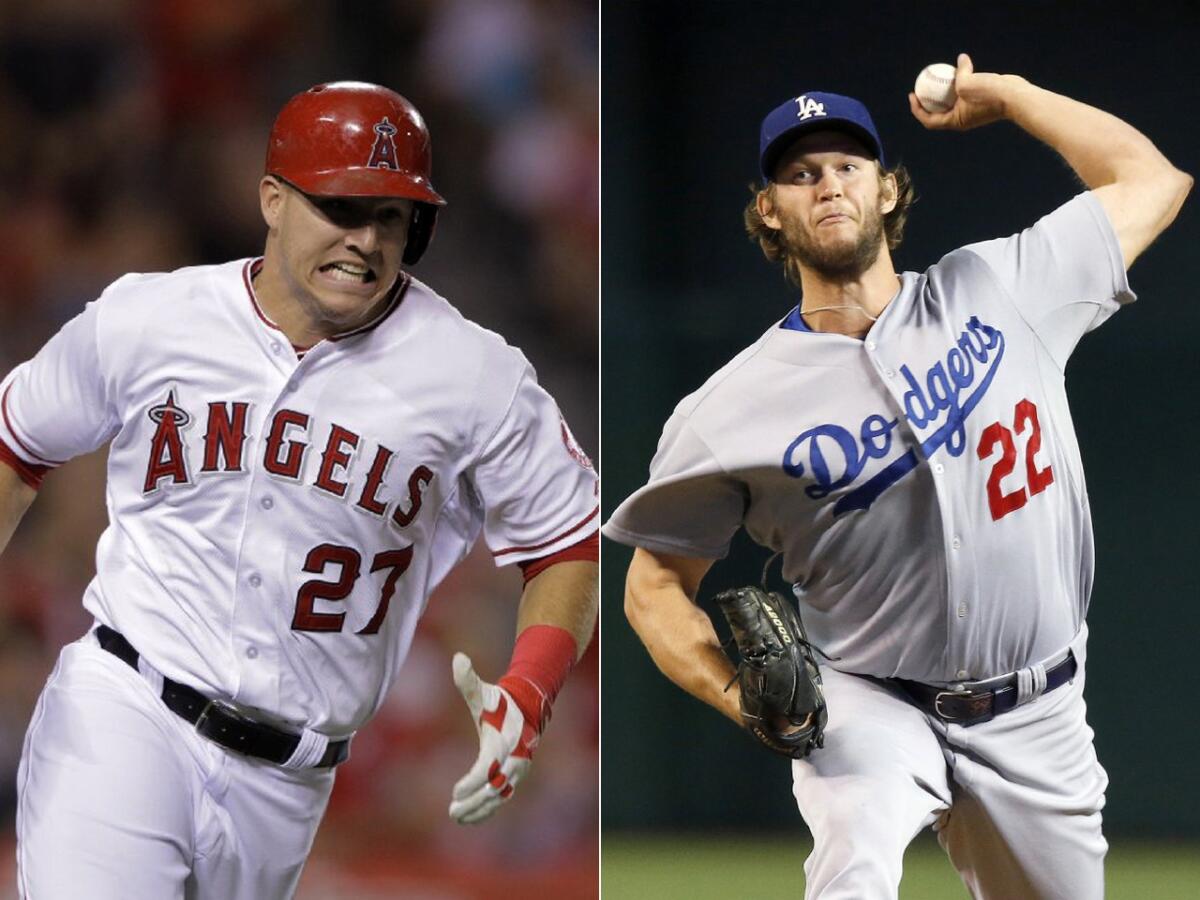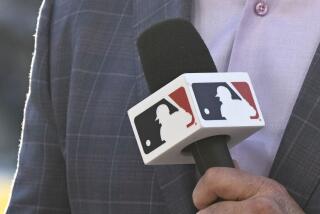MLB already has the National League but wants to be a national league

- Share via
Baseball’s torch has been passed to a new generation. Bud Selig, 80, who ruled Major League Baseball as commissioner for more than two decades — and without ever sending an email — has retired. In his place is Rob Manfred, 56, who is hoping that grass-roots outreach and cutting-edge technology will help him revitalize a game that has endured a long and steady slide from its days as the national pastime.
“This fight,” Manfred said, “is not lost.”
Television ratings, the most widely circulated measure of a sport’s popularity, do not bode well for baseball. The World Series has lost more than half its national audience over the last three decades, and Game 5 of last year’s World Series was soundly thumped by a regular-season NFL game.
MLB’s television audience is also getting old. Half of its viewers are 55 or older, up from 41% a decade ago, according to Nielsen research. That demographic accounts for 37% of NFL viewers, 29% of NHL viewers and 25% of NBA viewers.
One of Manfred’s primary goals is to engage young people and nurture them into lifetime fans. If their grandparents want to share stories of watching Sandy Koufax pitch for the Dodgers, so much the better, but baseball’s new pitch does not rely on the nostalgia that long has been one of the game’s primary selling points.
Mark Walter, the Dodgers’ controlling owner, said Manfred already is working on multiple fronts to engage a generation that has grown up on video games. “It’s not just flipping the switch and making it better,” Walter said.
Manfred plans to use media and technology to make games more compelling — at the ballpark, on television, and on computers and mobile devices. He ousted the league’s longtime business chief and promoted the leaders of MLB Network and MLB Advanced Media (MLBAM) to take charge of the sport’s business operations.
MLBAM might be the biggest success story in sports technology, running websites for MLB, other sports leagues and rock stars. Manfred said that 5.7 million people a day — with an average age of 33 — use MLBAM’s MLB.com At Bat app every day during the season.
“There is nothing that attracts kids like technology,” Manfred said.
The At Bat app, designed for mobile devices, offers one-stop access to game broadcasts, highlights, scores, statistics and news, all constantly updated. For six consecutive years, it has been the highest-grossing mobile sports app, according to MLB.
As viewing habits evolve from a generation sitting in front of the television to one demanding video access at any time, in any place and on any device, the league’s website delivered more than 2.5 billion video streams last year.
San Francisco Giants President Larry Baer said “the technology curve . . . is moving 100 mph,” with MLBAM putting baseball in position to win over the next generation of sports fans. “I think that not only is it not a lost generation, it’s a generation that we can capture uniquely,” he said.
The league has developed its own easy-to-play video games, designed for mobile devices and targeting young fans with such iconic names as RBI Baseball and Home Run Derby. It also has devised technologies that transcend traditional statistics and now can show, for example, just how much Clayton Kershaw’s curveball curves and how far and fast Mike Trout ran to catch a fly ball.
“When you think about it, baseball in some ways is ideally suited for the Internet and for technology,” Baer said. “It’s statistics-rich. There are a lot of games. There’s a lot of ways to access those games. The games are played every day. They’re played during the summer, when people have free time, and time to experiment and do things.”
In the past, baseball’s reform efforts have largely focused on ways to quicken the pace of play, but MLB executives realize knocking 10 minutes off a three-hour game is far from a panacea.
“Obviously, the attention span of children seems to be getting smaller,” Pittsburgh Pirates President Frank Coonelly said. “We need to make sure we are recognizing that, and putting a product before them that they can consume in a way they like to consume it.
“Pace of game is certainly part of it, but that is only one part of it.”
Manfred said it is important that baseball engage young people not only as fans, but also as participants.
“It’s important to have the best athletes in order to make our game compelling,” he said, “and it’s important for kids to play, because all the studies show it’s the first step to becoming a fan.”
The number of Americans playing baseball dropped 14.5% from 2008 to 2013, according to the latest research by the Sports and Fitness Industry Assn. But participation rose 2.4% from 2012 to ‘13, enabling baseball to pass outdoor soccer as the second-most popular recreational sport with the 13.3 million participants, trailing only basketball.
Among children ages 6 through 12, one in three plays baseball, according to the SFIA. Manfred wants to build on that base using an initiative he calls “One Baseball,” lending MLB support to the game at the youth, high school and college levels.
MLB is working with orthopedists and USA Baseball on the “Pitch Smart” program, designed to combat overuse injuries among young pitchers. The league also is developing a website and app that youth coaches can use to design practice plans and drills. The details of a comprehensive youth initiative are expected to be announced this summer.
Baseball’s new regime will also be trying to ramp up national exposure for a game that has become increasingly localized.
Regional sports networks provide a growing share of baseball’s revenue, and even the so-called “Game of the Week” broadcasts each Saturday feature several games for maximum local ratings, rather than the one game that would provide the greatest exposure.
That trade-off — more of the home team, less of all other teams — bites baseball during the playoffs and World Series, when casual fans tune out if their team has been eliminated.
“Our brands have real strength,” Baer said. “If you are a Yankee fan in New York or a Cub fan in Chicago or a Dodger fan in L.A., it’s huge. How do we create the national overlay and do some things nationally?”
The Dodgers’ Kershaw and the Angels’ Trout, most valuable players in their respective leagues last season, are big-city stars with youthful appeal — Kershaw the tough, square-jawed left-hander with the knee-buckling curve; Trout the power-hitting phenom who scales outfield fences to steal would-have-been home runs.
But baseball would also benefit from a national spotlight on a smaller-market player such as Pittsburgh Pirates outfielder Andrew McCutchen, a dynamic and personable star who preceded Kershaw as MVP of the National League.
“In our market, we don’t have any difficulty marketing Andrew McCutchen to our fan base,” Coonelly said. “He’s one of the very best players in the game. He does things the right way. He works extraordinarily hard. He gives back to the community. He is somebody that can be and is a role model to so many of the kids.
“Andrew can and should be a national star.”
One strong barometer of widespread appeal is endorsement revenue.
Derek Jeter of the New York Yankees, who retired after last season, made $9 million per year in endorsement revenue, but no other baseball player made more than $5 million, according to the most recent Forbes estimates of athlete income. In the basketball, Kobe Bryant of the Lakers made $31 million from endorsements — and LeBron James of the Cleveland Cavaliers made $53 million.
Baseball players catching up to the likes of Bryant and James might not be realistic — kids wear basketball shoes to school, not baseball cleats — but if MLB can narrow the gap in endorsement revenue it would be a sign that its national profile is on the rise. The young sports fan in L.A. might already be wearing a Kershaw shirt. Baseball wants to see the same shirt in Chicago, New York and Miami.
“It is important for us to continue to expand our partnership with the players in a way that makes stars — national stars — out of our very best players,” Manfred said. “If you do a good job marketing your players all year long, and Clayton Kershaw is a big star and it’s ‘the Los Angeles Dodgers and Clayton Kershaw’ in the postseason, I think it helps you, in terms of a national audience.”
Follow Bill Shaikin on Twitter @BillShaikin
More to Read
Go beyond the scoreboard
Get the latest on L.A.'s teams in the daily Sports Report newsletter.
You may occasionally receive promotional content from the Los Angeles Times.











